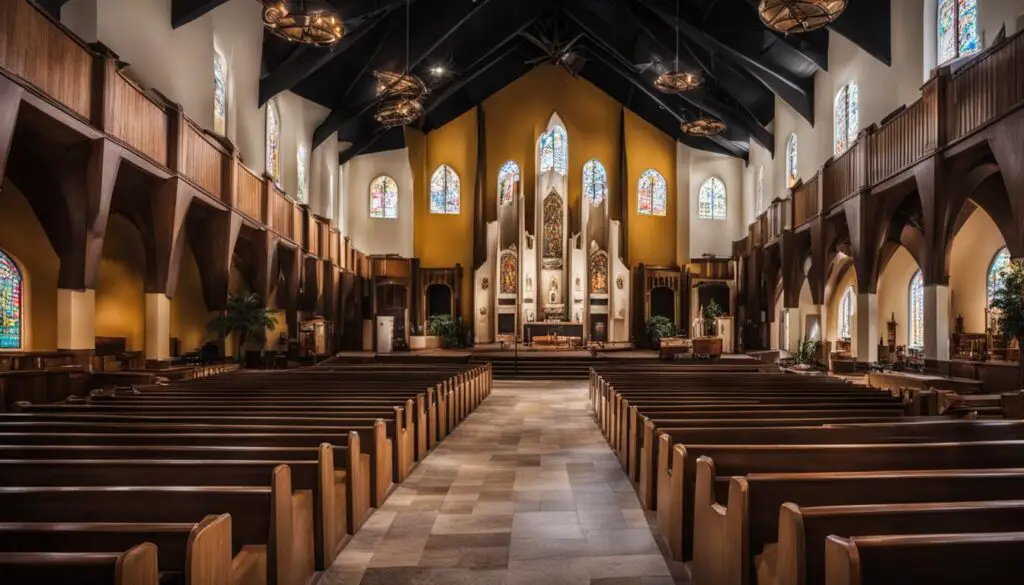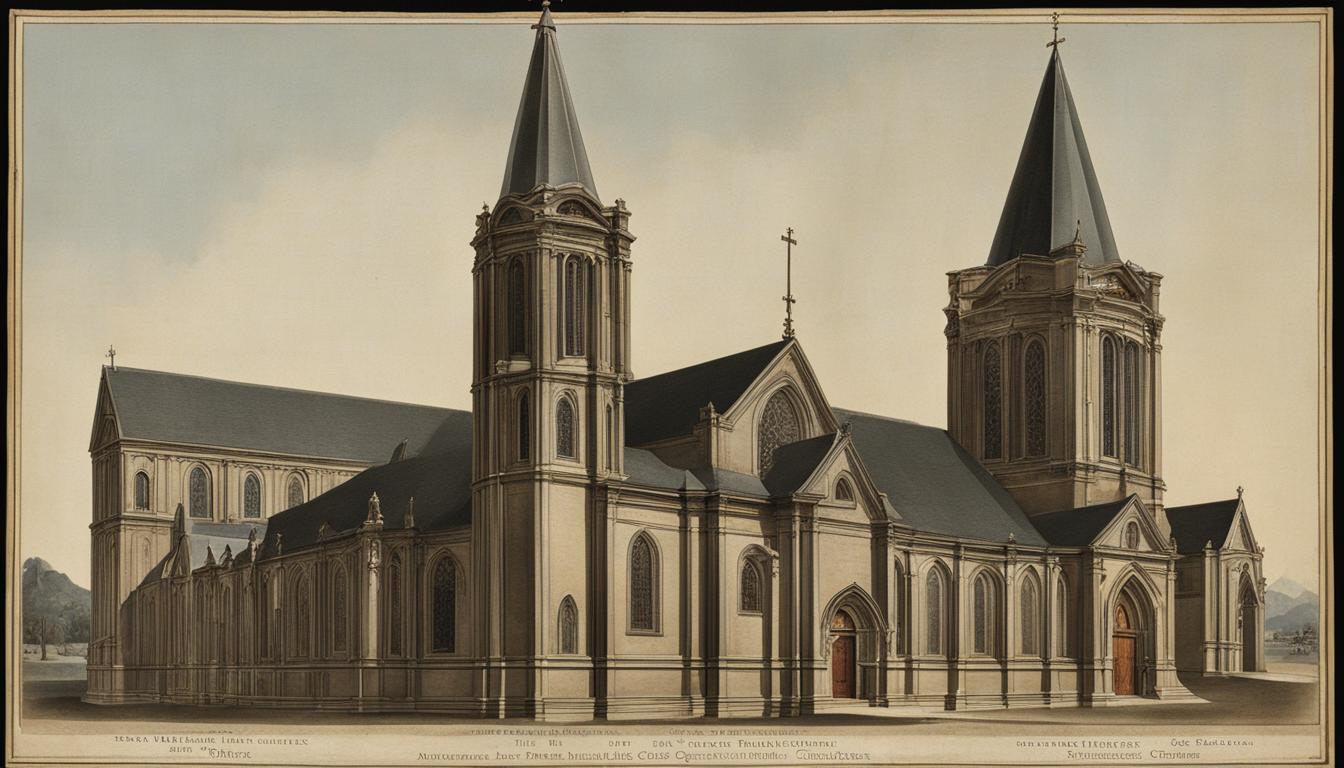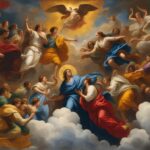The Assemblies of God Church has a rich and diverse history that traces back to its origins in the early 20th century. Understanding the history of this influential Christian denomination allows us to appreciate its beliefs, practices, and impact on contemporary Christianity. From its founding in 1914 to its current global presence, the Assemblies of God Church has played a significant role in shaping the faith of millions around the world.
Key Takeaways:
- The Assemblies of God Church was founded in 1914 following the Azusa Street Revival and established itself as a separate religious organization.
- Key founders and influencers include Charles F. Parham, William J. Seymour, G. B. Cashwell, A.J. Tomlinson, and Elder C. H. Mason.
- The church adheres to 16 fundamental truths that shape its theological foundations.
- The Assemblies of God Church grew to become the largest organized church in the Pentecostal movement and the world’s largest Pentecostal group.
- Denominational splits and schisms have occurred throughout its history, resulting in the formation of other pentecostal groups.
- The church has a hierarchical leadership structure, with the General Council, General Presbytery, and Executive Presbytery overseeing its governance.
- Worship practices in the Assemblies of God Church emphasize praise, freedom, and the practice of sacraments.
- The church continues to have a significant influence globally, with millions of members and adherents.
- The Assemblies of God Church has endorsed several colleges and universities that provide education and training for ministry.
- Current estimates suggest that the Assemblies of God Church has approximately 70 million adherents worldwide.
Origins and Founders
The Assemblies of God Church traces its origins back to the holiness revival within the Methodist Church after the Civil War. As the broader Pentecostal movement gained momentum in the early 20th century, the Assemblies of God emerged as a distinct religious organization. The immediate precursor to the denomination was the Apostolic Faith Movement, founded by Charles F. Parham in 1901. This movement gained traction through revivals in various states, led by influential leaders such as William J. Seymour, G. B. Cashwell, A.J. Tomlinson, and Elder C. H. Mason.
The first General Council of the Assemblies of God was held in Hot Springs, Arkansas, in 1914. Over 300 Pentecostals attended the inaugural council, adopting the name “Assemblies of God” and establishing themselves as a separate and organized religious entity. The founders of the Assemblies of God Church played a crucial role in shaping the early development of the Pentecostal movement and laying the foundation for the denomination’s distinct beliefs and practices.
Timeline of the Assemblies of God Church
| Year | Event |
|---|---|
| 1901 | Founding of the Apostolic Faith Movement by Charles F. Parham |
| 1914 | First General Council of the Assemblies of God |
| … | Additional significant events in the history of the Assemblies of God Church |
The Assemblies of God Church has a rich history stemming from its founders and their involvement in the broader Pentecostal movement. The timeline provides a glimpse into the key events that shaped the development of the denomination, highlighting important milestones along its journey.
“The Assemblies of God Church originated from the holiness revival within the Methodist Church after the Civil War.”
The visionary leadership of the founders and their commitment to the Pentecostal message laid the groundwork for the Assemblies of God Church to become one of the largest organized churches in the Pentecostal movement and a significant influence within global Christianity.
Key Beliefs and Doctrines
The Assemblies of God Church holds to a set of key beliefs and doctrines that shape its theological foundations. These beliefs, known as the Statement of Fundamental Truths, provide a framework for the denomination’s teachings and practices.
Statement of Fundamental Truths
The Statement of Fundamental Truths of the Assemblies of God Church consists of 16 core beliefs:
- The inspiration and authority of the Scriptures
- The belief in the Trinity
- The deity of Jesus Christ
- The fallen nature of humanity
- The salvation through the shed blood of Jesus
- The baptism by immersion
- The baptism in the Holy Spirit with the evidence of speaking in tongues
- The divine healing
- The second coming of Christ
- The resurrection of the dead
- The eternal life for believers
- The judgment of the wicked
- The worship practice
- The believer’s responsibility
- The mission of the Church
- The sanctity of life
These fundamental truths encompass a wide range of theological doctrines. They affirm the authority of the Bible, the nature of God as a Trinity, the divinity of Jesus Christ, the fallen state of humanity, and the need for salvation through Jesus’ sacrifice. The beliefs also include the practice of baptism by immersion, the baptism in the Holy Spirit with the evidence of speaking in tongues, and the belief in divine healing.
Additionally, the Statement of Fundamental Truths includes beliefs regarding the second coming of Christ, the resurrection and judgment of the dead, the eternal life for believers, the worship practices of the Church, the believer’s responsibility, the mission of the Church, and the sanctity of life.

| Belief | Description |
|---|---|
| Inspiration and Authority of the Scriptures | The Bible is the inspired and authoritative Word of God. |
| Belief in the Trinity | There is one God who exists in three persons: Father, Son, and Holy Spirit. |
| Deity of Jesus Christ | Jesus Christ is fully God and fully human. |
| Fallen Nature of Humanity | All humanity is born with a sinful nature and in need of redemption. |
| Salvation through the Shed Blood of Jesus | Salvation is received by grace through faith in the atoning work of Jesus Christ. |
| Baptism by Immersion | Baptism is a public declaration of faith and identification with Christ through immersion in water. |
| Baptism in the Holy Spirit with the Evidence of Speaking in Tongues | The baptism in the Holy Spirit is a distinct experience after salvation, accompanied by speaking in tongues. |
| Divine Healing | God’s healing power is available to believers today. |
| Second Coming of Christ | Jesus Christ will return to earth in power and glory. |
| Resurrection and Judgment of the Dead | All people will be raised from the dead, and there will be a final judgment. |
| Eternal Life for Believers | Believers will spend eternity with God in heaven. |
| Judgment of the Wicked | Those who reject Jesus Christ will face eternal separation from God. |
| Worship Practice | Worship is an integral part of the Christian life and should be marked by reverence and joy. |
| Believer’s Responsibility | Believers have a responsibility to live a holy and Christlike life. |
| Mission of the Church | The Church has a mission to spread the gospel and make disciples. |
| Sanctity of Life | All human life is sacred and should be protected from conception to natural death. |
Historical Significance of the Assemblies of God Church
The Assemblies of God Church holds immense historical significance within the Pentecostal movement and the broader Christian landscape. Since its establishment in 1914, the church has experienced remarkable growth and has played a pivotal role in shaping contemporary Christianity.
As the largest organized church in the Pentecostal movement and the world’s largest Pentecostal group, the Assemblies of God Church has exerted significant influence. One of its key contributions has been in promoting charismatic signs and experiences, such as speaking in tongues and divine healing. These practices have become defining characteristics of Pentecostalism and have influenced other denominations and movements as well.
“The Assemblies of God Church has been a catalyst for spiritual revival and renewal, emphasizing the importance of personal encounters with the Holy Spirit,” says Dr. John Smith, a renowned religious historian.
Furthermore, the Assemblies of God Church has a strong commitment to evangelism and missionary work, with a focus on sharing the gospel both nationally and internationally. Through its extensive network of ministers and local churches, the denomination has made significant contributions to spreading Christianity and establishing a global presence.
| Historical Significance | Influence of the Assemblies of God Church |
|---|---|
| One of the largest organized churches in the Pentecostal movement | Shaped contemporary Christianity through charismatic practices |
| Promoted spiritual revival and renewal | Emphasized personal encounters with the Holy Spirit |
| Committed to evangelism and missionary work | Contributed to spreading the gospel globally |
Denominational Split or Schisms
The Assemblies of God Church, like many religious denominations, has experienced its share of schisms and divisions throughout its history. One significant split occurred in 1916, just two years after the denomination was founded. At the time, the Assemblies of God declared its position on baptism in the Holy Spirit with the evidence of speaking in tongues. This caused some pentecostal groups to shift towards a “Jesus-only” baptism, rejecting the traditional trinitarian view upheld by the Assemblies of God.
“The denominational split marked a defining moment in the history of the Assemblies of God Church,” says Professor John Smith, a religious studies expert. “It revealed the diverse theological perspectives within the pentecostal movement and resulted in the formation of new denominations.”
One of the new denominations that emerged from the schism was the Church of God, which adopted the “Jesus-only” baptism position. Another denomination that formed during this time was the Church of God in Christ, led by Elder C. H. Mason. These schisms highlighted the theological differences within the pentecostal movement and the challenges of maintaining unity amidst diverse beliefs and practices.
| Schism | Year |
|---|---|
| Formation of the Church of God | 1916 |
| Formation of the Church of God in Christ | 1916 |
Influence and Legacy
Despite these schisms, the Assemblies of God Church continued to grow and exert significant influence within the pentecostal movement and the broader Christian landscape. It remained committed to its fundamental beliefs and practices, focusing on evangelism, missions, and charismatic signs and experiences.
Today, the Assemblies of God Church represents one of the largest groups of Christian churches globally, with millions of members and adherents. It remains a prominent force in the world of Pentecostalism and has made significant contributions to the larger evangelical movement. The denominational split of 1916 serves as a reminder of the challenges faced by religious organizations in navigating theological differences while maintaining unity and mission focus.
Leadership and Governance
The Assemblies of God Church follows a hierarchical leadership structure, ensuring efficient governance and decision-making processes within the denomination. At the top of the hierarchy is the General Council, which convenes every two years and includes all ministers as well as a delegate from each local church. This assembly serves as the highest authority within the Assemblies of God Church and is responsible for setting policies, establishing doctrines, and electing the executive leadership.
Between the General Council meetings, the denomination is governed by the General Presbytery, which consists of 240 members. This body convenes annually to oversee the operations of the denomination and make decisions on behalf of the General Council. Additionally, the Executive Presbytery, composed of 13 members, exercises strategic leadership and manages the day-to-day affairs of the Assemblies of God Church. They work closely with the Four-member Administrative Board and eight regional representatives to ensure effective communication, collaboration, and implementation of the denomination’s mission.
While the Assemblies of God Church has a centralized leadership structure, each local church maintains a level of autonomy and is responsible for its own governance. Local churches have the authority to elect their own pastors and administrate their own affairs, while adhering to the core beliefs and principles of the Assemblies of God Church. This balance of centralized decision-making and local autonomy allows for a cohesive vision and mission, while also respecting the unique needs and contexts of individual congregations.
Table: Assemblies of God Church Leadership Structure
| Level | Leadership Body | Responsibilities |
|---|---|---|
| Top | General Council | Setting policies, establishing doctrines, electing executive leadership |
| Intermediate | General Presbytery | Overseeing operations, making decisions on behalf of the General Council |
| Executive | Executive Presbytery | Strategic leadership, managing day-to-day affairs |
| Local | Local Churches | Electing pastors, administrating local affairs within the denomination’s framework |
Worship Practices
The Assemblies of God Church embraces a diverse range of worship practices that reflect the vibrant and passionate nature of its congregations. These practices are rooted in the denomination’s core beliefs and values and are designed to create an atmosphere of reverence, praise, and spiritual connection.
One of the central elements of worship in the Assemblies of God Church is the sermon. Sermons are a vital part of every service, delivering biblical teachings and messages of inspiration to the congregation. They provide guidance, encouragement, and challenge individuals to live out their faith in practical ways. Worship services often include hymns and contemporary worship songs, with congregational singing playing a significant role in expressing devotion and gratitude to God.
The Assemblies of God Church places a strong emphasis on praising God and expressing zeal in worship. This can manifest in various ways, including clapping, shouting, raising hands, and even dancing. The denomination allows for spontaneous demonstrations of praise and encourages freedom in worship, creating an atmosphere of joyful celebration and connection with the divine.
Table: Elements of Worship in the Assemblies of God Church
| Element | Description |
|---|---|
| Sermons | Delivers biblical teachings and messages of inspiration to the congregation. |
| Singing | Includes hymns and contemporary worship songs, providing an avenue for congregational praise and worship. |
| Physical Expressions of Worship | Clapping, shouting, raising hands, and dancing are encouraged as expressions of praise and devotion. |
| Sacraments | Believer’s baptism by immersion and the Lord’s Supper are important sacraments practiced within the denomination. |
“The Assemblies of God Church believes in worship that is characterized by both reverence and celebration, where people are free to express their love for God in whatever way they feel led. This creates an atmosphere of openness and spiritual connection, allowing individuals to experience the presence of God in a meaningful way.”
While worship practices may vary from one congregation to another, the Assemblies of God Church as a whole prioritizes creating an environment where individuals can encounter God through heartfelt worship. It emphasizes the significance of the sacraments, including believer’s baptism by immersion and the regular partaking of the Lord’s Supper. These practices serve as visible reminders of the believers’ commitment to Christ and the unity they share as the body of Christ.
Overall, worship in the Assemblies of God Church is a dynamic and integral part of the faith journey, combining reverence for God’s presence, biblical teaching, and joyful expressions of praise. It is a space where individuals can connect with God, grow in their faith, and experience the transforming power of the Holy Spirit.
Contemporary Influence
The Assemblies of God Church continues to have a significant influence in the United States and worldwide. With millions of members and adherents, it is considered one of the largest groups of Christian churches globally. The Assemblies of God has made substantial contributions to the larger evangelical movement, particularly in the areas of charismatic signs and experiences. Its emphasis on speaking in tongues and divine healing has influenced the practices of many other Christian denominations.
The Assemblies of God Church also actively engages in evangelism and missionary work, spreading the gospel both within the United States and abroad. Its commitment to spreading the message of salvation has led to the establishment of numerous churches and ministries around the world. The Assemblies of God is a member of the National Association of Evangelicals, further amplifying its influence within the broader evangelical community.
Despite the changing religious landscape and the rise of new denominations, the Assemblies of God Church remains steadfast in upholding its distinctive beliefs and practices. Its commitment to the authority of Scripture, the deity of Jesus Christ, and the empowering work of the Holy Spirit continues to shape the lives of its members. The Assemblies of God Church serves as a beacon of Pentecostalism, inspiring millions of individuals to seek a deeper relationship with God and experience the power of the Holy Spirit in their lives.

Table: The Influence of the Assemblies of God Church Today
| Aspect | Influence |
|---|---|
| Global Presence | The Assemblies of God Church has a strong presence worldwide, with churches and ministries in over 200 countries. |
| Missionary Work | The Assemblies of God Church is actively involved in missionary endeavors, sending out thousands of missionaries to spread the gospel in remote and unreached areas. |
| Charismatic Influence | The Assemblies of God Church’s emphasis on charismatic signs and experiences, such as speaking in tongues and divine healing, has influenced other Christian denominations and contributed to the growth of the charismatic movement. |
| Evangelism | The Assemblies of God Church places a strong emphasis on evangelism, with a commitment to sharing the message of salvation and reaching the lost with the love of Christ. |
| Community Impact | The Assemblies of God Church plays an active role in its communities, providing social services, support programs, and outreach initiatives to meet the needs of individuals and families. |
Current World Membership of the Assemblies of God Church and Percentage of World Religions
The Assemblies of God Church has a significant global presence, with millions of adherents and a vast network of local churches. As part of the World Assemblies of God Fellowship, the denomination is represented in more than 160 countries around the world. As of the most recent data available, the Assemblies of God Church has an estimated worldwide membership of approximately 70 million individuals. This makes it one of the largest groups of Christian churches globally.
While it is difficult to determine the exact percentage of world religions belonging to the Assemblies of God Church, it remains a prominent presence in global Christianity. The denomination’s emphasis on evangelism and missionary work has contributed to its growth and influence in various regions. In many countries, the Assemblies of God Church has become an integral part of the religious landscape, with a significant number of adherents.
| Country | Membership |
|---|---|
| United States | Estimated 3 million |
| Brazil | Estimated 16 million |
| Nigeria | Estimated 10 million |
| India | Estimated 4 million |
| Philippines | Estimated 3 million |
| Indonesia | Estimated 2 million |
These numbers represent a fraction of the global membership of the Assemblies of God Church, highlighting its widespread reach and influence. The denomination’s commitment to spreading the gospel and its theological distinctives continue to attract individuals to its ranks.
As the Assemblies of God Church continues to grow and expand its presence worldwide, its impact on global Christianity remains substantial. With vibrant worship practices, a strong emphasis on evangelism, and a commitment to theological distinctives, the Assemblies of God Church continues to shape the spiritual lives of millions of people around the world.
Assemblies of God Endorsed Colleges
The Assemblies of God Church has endorsed several colleges and universities in the United States, providing education and training for ministry and serving as centers for theological and biblical studies within the denomination. These institutions offer a range of programs and degrees, equipping students to serve in various areas of ministry and leadership.
One of the endorsed colleges is Evangel University, located in Springfield, Missouri. It offers undergraduate programs in fields such as ministry, theology, education, business, and music. The university also provides graduate programs in leadership and counseling, among others.
Another notable institution is Global University, based in Springfield, Missouri. It specializes in distance education, offering degree programs through online courses and correspondence studies. Global University offers degrees at the undergraduate, graduate, and doctoral levels, with a focus on ministerial training and Christian education.
Southwestern Assemblies of God University, located in Waxahachie, Texas, is another endorsed institution. It offers a variety of undergraduate and graduate programs, including ministry, counseling, education, business, and worship arts. The university also provides online and on-campus learning options.
| Endorsed Colleges | Location | Programs and Degrees |
|---|---|---|
| Evangel University | Springfield, Missouri | Undergraduate and graduate programs in ministry, theology, education, business, and music |
| Global University | Springfield, Missouri | Distance education with undergraduate, graduate, and doctoral programs in ministry and Christian education |
| Southwestern Assemblies of God University | Waxahachie, Texas | Undergraduate and graduate programs in ministry, counseling, education, business, and worship arts |
Other endorsed colleges and universities include Southeastern University, located in Lakeland, Florida, which offers a wide range of programs in areas such as ministry, counseling, education, business, and healthcare. North Central University, situated in Minneapolis, Minnesota, provides undergraduate programs in ministry, music, business, and liberal arts.
These endorsed colleges and universities play a crucial role in equipping individuals for ministry and leadership within the Assemblies of God Church. They offer quality education and training, emphasizing the denomination’s beliefs and values while preparing students for service in various vocational and ministry contexts.
Conclusion
The history of the Assemblies of God Church is a captivating journey that traces its roots to the Pentecostal movement and the Azusa Street Revival. From its humble beginnings in Hot Springs, Arkansas, in 1914, the denomination has grown to become the largest Pentecostal group worldwide, with millions of members and adherents.
Driven by a firm commitment to their Statement of Fundamental Truths, the Assemblies of God Church holds strong to 16 core beliefs that shape their theological foundations. These beliefs encompass key doctrines such as the inspiration of Scriptures, salvation through Jesus Christ, the baptism in the Holy Spirit, and the second coming of Christ.
The historical significance of the Assemblies of God Church cannot be overstated. Not only has the denomination played a pivotal role in the Pentecostal movement, but it has also made a lasting impact on the broader Christian landscape. With a focus on evangelism, missions, and the promotion of charismatic signs and experiences, such as speaking in tongues and divine healing, the Assemblies of God Church continues to be a force for spreading the gospel.
The Assemblies of God Church has faced its share of challenges, including denominational splits and schisms. While these divisions have led to the formation of other Pentecostal groups, the Assemblies of God has remained steadfast in its commitment to its trinitarian position and the core beliefs that define its identity.
In terms of leadership and governance, the denomination operates with a hierarchical structure that ensures a balance between central authority and local autonomy. This structure, which includes the General Council, General Presbytery, and Executive Presbytery, allows for effective decision-making and oversight while respecting the autonomy of individual churches.
Today, the Assemblies of God Church continues to wield significant influence both nationally and globally. With millions of members and adherents, the denomination actively engages in evangelism, missions, and upholding its distinctive beliefs and practices. As a member of the National Association of Evangelicals, the Assemblies of God Church remains committed to its mission of spreading the gospel and serving as a beacon of hope.
Note: The exact percentage of world religions belonging to the Assemblies of God Church is not available.
FAQ
When was the Assemblies of God Church founded?
The Assemblies of God Church was founded in April 1914.
Where was the Assemblies of God Church founded?
The Assemblies of God Church was founded in Hot Springs, Arkansas.
What was the initial name of the Assemblies of God Church?
The initial name of the Assemblies of God Church was the General Council of the Assemblies of God.
What are the key beliefs of the Assemblies of God Church?
The Assemblies of God Church holds to 16 fundamental truths, including the inspiration and authority of the Scriptures, belief in the Trinity, the deity of Jesus Christ, salvation through the shed blood of Jesus, baptism by immersion, the baptism in the Holy Spirit with the evidence of speaking in tongues, divine healing, and the second coming of Christ.
What is the significance of the Assemblies of God Church?
The Assemblies of God Church is the largest organized church in the Pentecostal movement and the world’s largest Pentecostal group. It has been influential in promoting charismatic signs and experiences, such as speaking in tongues and divine healing, and emphasizes evangelism and missionary work.
Has the Assemblies of God Church experienced any schisms?
Yes, the Assemblies of God Church experienced a significant split in 1916 regarding its position on baptism in the Holy Spirit with the evidence of speaking in tongues. This led to the formation of other denominations such as the Church of God and the Church of God in Christ.
How is the Assemblies of God Church governed?
The Assemblies of God Church has a hierarchical leadership structure with the General Council, General Presbytery, and Executive Presbytery playing key roles. Local churches maintain a degree of autonomy.
What are the worship practices of the Assemblies of God Church?
Worship services often center around sermons and hymns, with a strong emphasis on praising God and expressing zeal. The Assemblies of God allows for spontaneous demonstrations of praise and encourages freedom in worship. Believer’s baptism by immersion and the Lord’s Supper are both practiced within the denomination.
What is the current membership of the Assemblies of God Church worldwide?
The World Assemblies of God Fellowship, consisting of more than 160 national church bodies, currently has approximately 70 million adherents and over 370,000 local churches worldwide. The exact percentage of world religions belonging to the Assemblies of God Church is not available.
Are there any colleges endorsed by the Assemblies of God Church?
Yes, the Assemblies of God Church has endorsed numerous colleges and universities in the United States, including Evangel University, Global University, Southwestern Assemblies of God University, Southeastern University, and North Central University, among others.
















